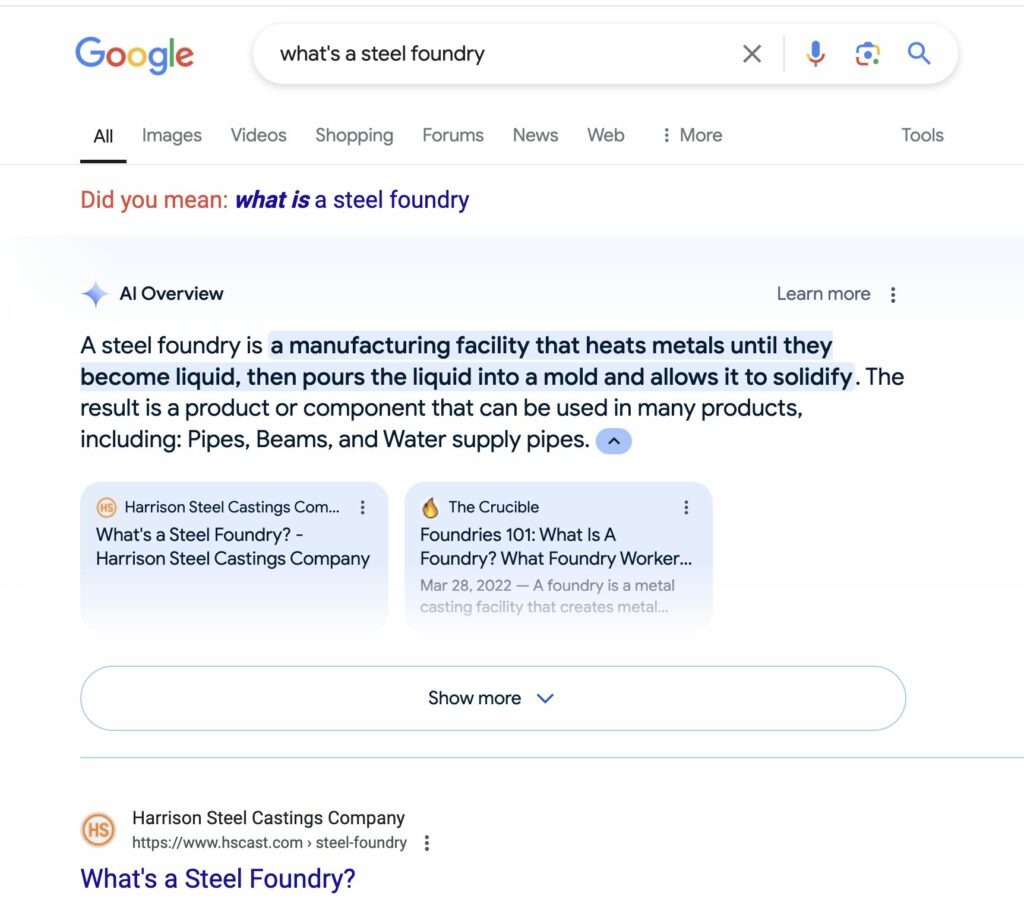Competing against industry giants with seemingly unlimited resources can be daunting, especially in competitive fields such as financial services, healthcare, and manufacturing. However, content marketing can be a great equalizer, allowing smaller companies to punch above their weight class in search engine rankings and content marketing effectiveness.
One of the more useful developments in content marketing is the pillar page. A pillar page—a deep and authoritative piece of long-form content that covers a topic in depth—can serve as the foundation for a cluster of related, more specific content pieces. The structure of a broader pillar page strategy allows businesses to organize their content in a way that’s both user-friendly and optimized for search engines. Smaller businesses can then establish authority in their niche and improve their website’s overall SEO performance.
Such an approach also provides a better user experience for their audience while allowing companies to efficiently create and organize content around core topics. As a result, smaller businesses can compete more effectively with larger companies for valuable search rankings.
In essence, a well-executed pillar page strategy enables smaller businesses to create a content ecosystem that demonstrates expertise, improves visibility, and attracts potential customers—without the need for vast resources. Creating high-quality, interconnected content that resonates with their target audience and search engines alike drives growth and success in their respective markets, proving once again that size isn’t always the determining factor for success.
What Is a Pillar Page Strategy?
A pillar page strategy is a content marketing approach that organizes a website’s content around core topics, creating a hierarchical structure that search engines and users can easily navigate. At the center of this strategy are pillar pages: comprehensive, authoritative pages that cover a broad topic in depth. These pillar pages are then linked to multiple related content pieces, known as cluster content, which delve into specific aspects of the main topic in greater detail.
How Does a Pillar Page Strategy Work?
Identify Core Topics: Start by determining the main topics that are most relevant to your business and audience. A digital marketing manager or SEO expert digs into the research to find the right combination of long-tail keywords, often questions actual visitors have about topics related to your products or services, before crafting an outline based on these user-generated concerns.
Create Pillar Pages: Write comprehensive, long-form content pages that cover each core topic broadly. These pages should be evergreen and provide a complete overview of the subject. And when we say long-form, we mean it: Most pillar pages are more than 3,000 words—with some as long as 5,000 or 6,000 words. Headings keep everything organized for readers.
Develop Cluster Content: Create a series of more focused, in-depth content pieces that relate to specific aspects of the pillar page topic. Just as a well-structured book guides readers through complex information, a pillar page strategy organizes a website’s content hierarchically, making it easy for both users and search engines to navigate and understand the relationships between different pieces of content.
Interlink Content: Link the pillar page and its related cluster content so that this web of interconnected, relevant content creates a unified signal to search engines that strengthens your site’s topical authority.
Optimize and Update: Regularly review and update both pillar pages and cluster content so that they remain current and valuable.

Why Does a Pillar Page Strategy Work?
Aligns with Search Engine Algorithm and Expectations: Search engines like Google favor websites that demonstrate experience, expertise, authoritativeness, and trustworthiness (E-E-A-T). A pillar page strategy helps establish these qualities by creating a structured, comprehensive body of knowledge on specific topics.
Improves User Experience: By organizing content logically, visitors can easily find related information, increasing engagement and time on site.
Boosts SEO: The interlinking structure strengthens the overall SEO of your website, potentially improving rankings for multiple related keywords.
Establishes Thought Leadership: Comprehensive pillar pages position your business as an authority in your field, building trust with your audience.
Increases Content Efficiency: This strategy provides a framework for content creation, helping teams focus their efforts on producing relevant, interconnected content.
Leveling the Playing Field for Smaller Businesses
A pillar page strategy can be particularly beneficial for smaller businesses for several reasons:
Cost-Effective: While creating pillar pages and cluster content requires an initial investment of time and resources, it’s a more efficient approach than producing large volumes of unrelated content. This allows smaller businesses to compete with larger competitors without matching their content production budgets.
Focused Expertise: Smaller businesses often specialize in niche areas. A pillar page strategy allows them to showcase their deep expertise in these specific topics, potentially outranking larger, more generalist competitors.
Improved Visibility: By concentrating efforts on key topics, smaller businesses can achieve higher search engine rankings for their target keywords, increasing their visibility to potential customers.
Long-Term Value: Pillar pages and their associated cluster content create a lasting resource that continues to drive traffic and leads over time, providing ongoing returns on the initial investment.
Scalable Strategy: As the business grows, the pillar page structure can be expanded to cover new topics or go into greater depth, allowing the content strategy to evolve alongside the company.
Competitive Differentiation: A well-executed pillar page strategy can help a small business stand out in a crowded market by demonstrating their unique expertise and approach to solving customer problems.
By focusing on creating high-quality, interconnected content around core topics, these businesses can establish authority, improve their SEO, and provide value to their audience. This structured approach to content marketing not only levels the playing field but can also give smaller, more agile companies an edge over larger competitors by showcasing their specialized knowledge and improving their online visibility. As search engines continue to prioritize quality content and user experience, a pillar page strategy will remain an essential tactic for businesses looking to grow their online presence and attract their target audience.
What Other Marketing Efforts Can Pillar Pages Support?
Because a pillar page is so comprehensive in its exploration of a core topic, it is an invaluable asset for various marketing efforts across channels. By centralizing key information and insights, it provides a solid foundation for creating consistent, authoritative content that can be repurposed and adapted for different formats and audiences. This centralized approach helps keep your messaging consistent across everything from social media posts to sales presentations. It provides sources for extracting bite-sized talking points for campaigns. or inspiring new content ideas across different marketing initiatives. In fact, depending on the approach, a single pillar page could yield more than a month’s worth of regular social media posts, which means the creation of a pillar page provides excellent ROI. A focused content investment—with a strategic approach and top-shelf execution—ensures cohesive brand messaging and reinforces your company’s expertise.
Brief Case Study: Harrison Steel and Strategic SEO
Rare Bird identified an opportunity to improve search rankings for the Harrison Steel Castings (HSC) website around two key industry terms—”Steel Foundry” and “Steel Casting”—in 2021. We conducted research on top-ranking competitors and discovered that many had outdated, informational content. Using keyword research tools, we developed a strategy to create superior, more informative content. In early 2023, two new pages were published on the HSC website: “What’s Steel Casting?” and “What’s a Steel Foundry?“
The results exceeded expectations, with the new pages ranking faster than anticipated. Within three months, the “Steel Foundry” page reached the number 1 position for its target keyword and related terms. The “Steel Casting” page, despite higher keyword difficulty, ranked 3rd after 12 months. Google Search Console data comparing January to April 2024 with the previous year showed a 160% increase in search impressions and a 25.6% increase in search clicks.
Additionally, HSC’s home page improved rankings for related phrases like “steel casting company” and “steel casting manufacturer”—proof of the value that pillar pages provide, even absent a full-blown content strategy and short posts to round out the cluster.

A well-executed SEO strategy like this begins by identifying relevant, high-traffic keywords and creating high-quality, informative content, Harrison Steel Castings significantly improved their organic search visibility and traffic. The success highlights the importance of keyword research, competitive analysis, and content optimization in driving measurable results online, while also emphasizing the need for patience in long-form, SEO-driven strategies.
Ready to work with an agency that has a proven track record of delivering real results for companies across nearly every industry and market sector?
You Might Also Like:
- What Is Modern Marketing?
- The Ultimate Guide to B2B Digital Marketing
- Email Marketing Works
- B2B Content Marketing: What to Do (and Not Do)
- Why Words Matter
Sign up for Bird Feed, our monthly newsletter, to receive articles like this in your inbox.